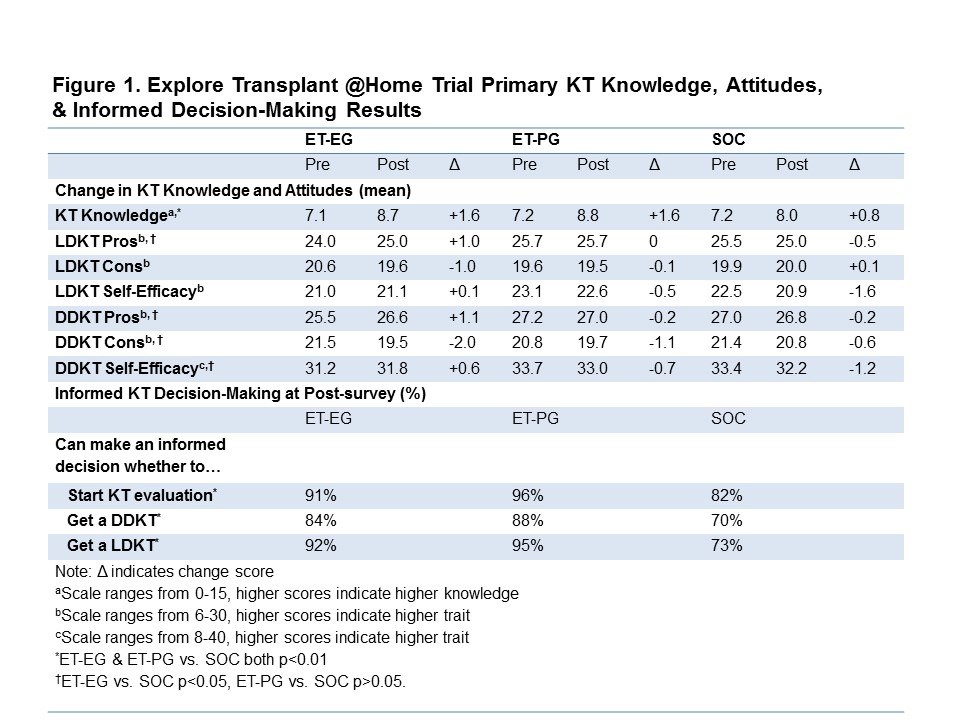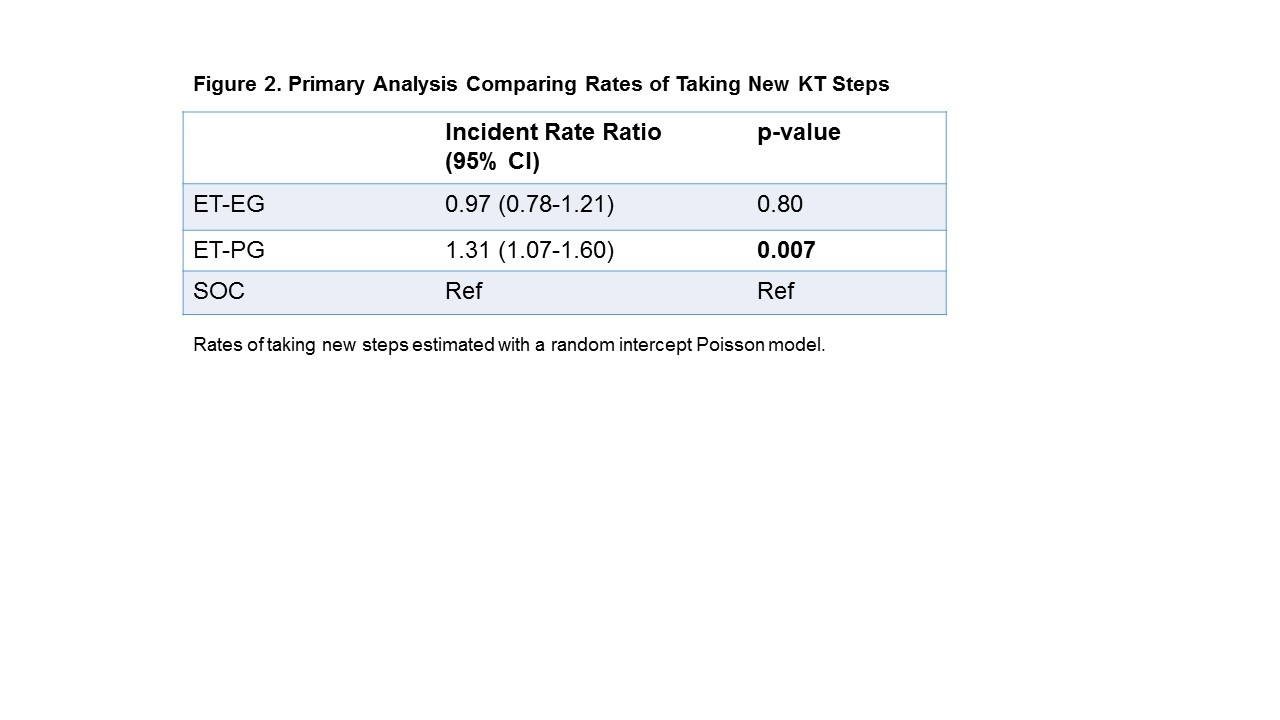Efficacy of At-Home Transplant Education on Transplant Knowledge and Pursuit in Low-Income and Black Dialysis Patients with Varying Educational Characteristics
Amy D Waterman1,2, John D Peipert1,2, Jennifer L Beaumont2.
1Division of Nephrology, David Geffen School of Medicine at UCLA, Los Angeles, CA, United States; 2Terasaki Research Institute, Los Angeles, CA, United States
Introduction: The Explore Transplant @ Home (ETH) randomized trial assessed efficacy of 2 supplementary education strategies relative to standard of care (SOC) for kidney transplant (KT) education in dialysis centers: 1) ETH, a video-based, patient-guided program where educational content is mailed and texted to patients (ET-PG) and 2) ET-PG plus educator-guided telephonic coaching (ET-EG).
Materials and Methods: A total of 561 patients were randomized to ET-EG (n=189), ET-PG (n=185), or SOC (n=187). Patients were selected based on being less likely to receive transplant education, targeting patients with low income (<250 % of the federal poverty level) and Black patients. Of these, 369 (71% Black) were included in the per-protocol analysis set (101 ET-EG, 108 ET-PG, 160 SOC). Exploratory analyses examined whether the effect of ET-EG or ET-PG, compared to SOC, differed by specific educational characteristics (e.g., pro-transplant attitudes and self-efficacy, previous transplant education received, health literacy and education levels) and potential transplant derailers (financial stability, social support, medical mistrust). Since this trial was not powered to detect interaction effects, this work is exploratory and p-values were not calculated.
Results: In the primary analyses, significant increases in KT knowledge at post-test were observed for both ET-EG and ET-PG compared to SOC. Significant increases in perceived pros to living and deceased donor transplant (LDKT and DDKT), reduced perceived cons to DDKT, and increased DDKT self-efficacy were seen for ET-EG. Patients receiving ET-PG had a higher rate of taking steps towards transplant in comparison to SOC. ET-EG more effectively increased LDKT self-efficacy for patients who had insufficient social support (6.6 pts, 95% CI: 2.6 – 10.6) than for those with sufficient support (0.2, 95% CI: -2.0 – 2.4), as well as for those with higher baseline LDKT pros (5.3, 95% CI: 2.3 – 8.2) than lower LDKT pros (-1.3, 95% CI: -3.9 – 1.2). ET-EG more effectively increased the number of steps taken toward KT compared to SOC among patients with more than a high school education (1.1 steps, 95% CI: 0.3 – 1.9), while patients with a high school education or less actually had a reduced number of steps taken compared to SOC (-0.9, 95% CI: -1.6 – -0.2). ET-PG more effectively increased LDKT self-efficacy for patients with higher baseline transplant knowledge (4.3, 95% CI: 1.5 – 7.1) than for those with less baseline knowledge (-1.7, 95% CI: -4.2 – 0.8).
Significant increases in perceived pros to living and deceased donor transplant (LDKT and DDKT), reduced perceived cons to DDKT, and increased DDKT self-efficacy were seen for ET-EG. Patients receiving ET-PG had a higher rate of taking steps towards transplant in comparison to SOC. ET-EG more effectively increased LDKT self-efficacy for patients who had insufficient social support (6.6 pts, 95% CI: 2.6 – 10.6) than for those with sufficient support (0.2, 95% CI: -2.0 – 2.4), as well as for those with higher baseline LDKT pros (5.3, 95% CI: 2.3 – 8.2) than lower LDKT pros (-1.3, 95% CI: -3.9 – 1.2). ET-EG more effectively increased the number of steps taken toward KT compared to SOC among patients with more than a high school education (1.1 steps, 95% CI: 0.3 – 1.9), while patients with a high school education or less actually had a reduced number of steps taken compared to SOC (-0.9, 95% CI: -1.6 – -0.2). ET-PG more effectively increased LDKT self-efficacy for patients with higher baseline transplant knowledge (4.3, 95% CI: 1.5 – 7.1) than for those with less baseline knowledge (-1.7, 95% CI: -4.2 – 0.8).
Conclusions: Supplementary patient- and educator-guided transplant education to Black and lower socioeconomic status dialysis patients can increase their transplant knowledge, self-efficacy, and steps taken to pursue transplant. Exploratory analyses suggest that these approaches may be even more effective in patients who are better-equipped at baseline to learn and pursue transplant, if interested.

